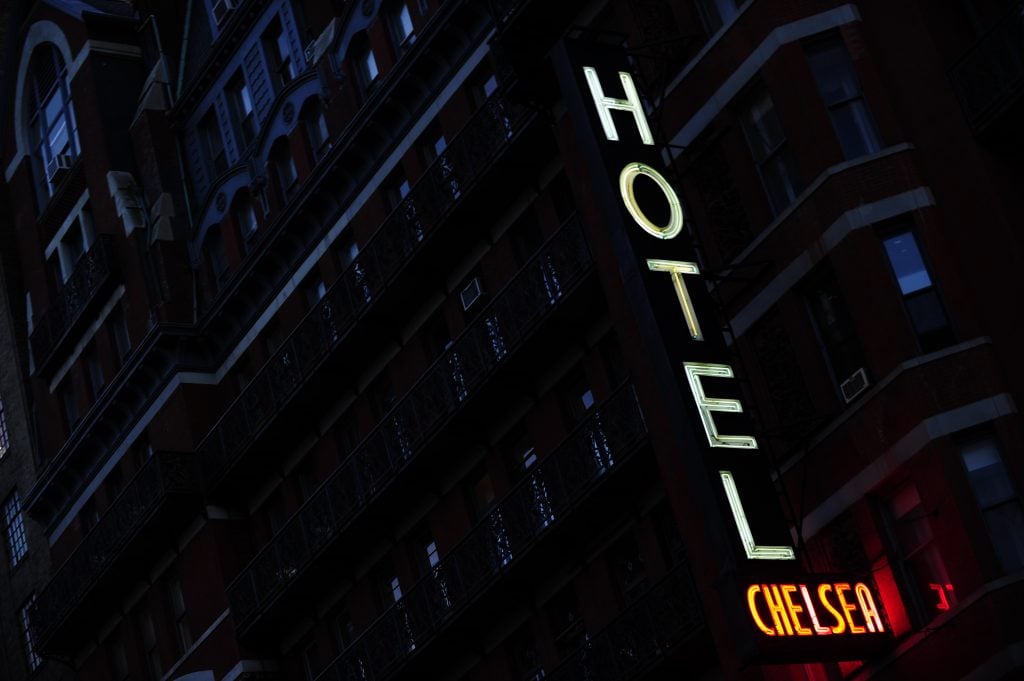The Chelsea Hotel, a historic landmark synonymous with New York’s bohemian past, has long been an emblem of artistic freedom and creativity. For decades, it served as a sanctuary for writers, musicians, and artists alike, drawing the likes of Madonna, Jean-Michel Basquiat, Bob Dylan, Patti Smith, and Janis Joplin, among countless others. Now, one of the hotel’s most recognizable features—the iconic neon sign—is being auctioned off by Guernsey’s auction house, offering an unparalleled opportunity for collectors and fans to own a piece of this cultural monument.
The auction of the Chelsea Hotel’s neon sign is far more than a simple sale of memorabilia; it symbolizes the intersection of art, history, and the rapidly changing landscape of New York City. As each of the letters from the vertical “Hotel” portion of the sign is sold individually, with bids starting at $2,500 per letter, and the “Chelsea” portion auctioned as a single lot starting at $20,000, this event reflects the tensions between preservation and commercialization. It raises questions about how we value and protect cultural heritage in an era where the city’s historic landmarks are increasingly repurposed, redeveloped, or demolished in favor of modernization.
This auction marks a significant moment not only in the history of the Chelsea Hotel but also in the ongoing narrative of New York’s cultural evolution. It is a testament to the city’s artistic legacy, while also underscoring the risks of commodifying cultural artifacts from the past.
The Chelsea Hotel: A Haven for the Avant-Garde
The Chelsea Hotel has long been a mythic place, its halls steeped in the legends of artistic and countercultural rebellion. Built in 1884, the hotel became a haven for artists, musicians, writers, and performers in the mid-20th century. It attracted a cast of colorful and influential residents who not only stayed at the hotel but also created and connected within its walls.
The Chelsea was more than just a hotel; it was a crucible for some of the most influential works of art, literature, and music of the 20th century. Dylan Thomas famously lived—and died—at the Chelsea, writing some of his most important poetry there. Arthur C. Clarke penned “2001: A Space Odyssey” while staying at the hotel. Leonard Cohen and Janis Joplin’s romantic entanglements played out within its walls, inspiring Cohen’s song “Chelsea Hotel #2.” Andy Warhol filmed “Chelsea Girls” at the hotel, forever cementing its status as a symbol of the avant-garde.
The hotel’s residents were not merely guests; they were part of a larger creative ecosystem, each contributing to the broader cultural narrative of the time. It was a place where art wasn’t simply consumed but created and lived. The Chelsea Hotel, with its dilapidated grandeur and artistic chaos, represented the beating heart of New York’s artistic scene, especially during the 1960s and 1970s.
The Sign: A Beacon of the Chelsea’s Legacy
The neon sign that once loomed large over the Chelsea Hotel was as much a part of its identity as the artists who stayed there. The sign’s towering letters, glowing in red neon, proclaimed the hotel’s name to passersby, inviting them into the storied halls within. More than a simple marker, the sign became a symbol of the hotel’s bohemian spirit, a beacon for those seeking a place where creativity thrived, unbound by societal norms.
The sign’s design—bold, vertical letters spelling out “HOTEL” and the horizontal “Chelsea” emblazoned beneath it—reflects the iconic mid-century New York aesthetic, embodying a certain gritty charm. Its design harks back to a time when neon signs lit up the streets of New York, each one representing a unique story, a different slice of life in the city that never sleeps. In the case of the Chelsea Hotel, the sign was more than a functional object; it was a vital part of the hotel’s identity, recognized by locals and tourists alike as a symbol of New York’s artistic soul.
The sign became shorthand for the Chelsea’s mystique, an emblem of both its artistic legacy and its status as a cultural landmark. It was a silent witness to the comings and goings of some of the most influential artists of the 20th century, a glowing symbol that presided over the many stories, collaborations, and dramas that played out within the hotel’s walls. For those who lived or worked at the Chelsea, the neon sign wasn’t just a piece of hotel branding—it was part of the fabric of their creative lives, a constant presence as they navigated their work and relationships in one of the most artistically fertile environments in New York.
The Auction: A Piece of History, Now a Commodity
The decision to auction off the Chelsea Hotel’s sign, piece by piece, raises significant questions about how we treat cultural artifacts in today’s world. While the sale offers collectors a rare chance to own a piece of New York history, it also serves as a stark reminder of the ongoing commercialization of the city’s cultural heritage. Each letter of the “HOTEL” portion of the sign will be auctioned as individual lots, turning the once cohesive beacon into fragmented pieces to be scattered across the world. The “Chelsea” portion will remain intact as a single lot, but even so, the auction underscores the way in which iconic symbols of culture are increasingly commodified, reduced to objects for sale rather than preserved as part of a shared cultural legacy.
There’s a certain poignancy in the auction of this particular sign. The Chelsea Hotel was always a place that represented the freedom of artistic expression, a refuge for those who eschewed conventional lifestyles in favor of creative pursuits. Now, the disassembly and sale of its neon sign could be seen as symbolic of the city’s gentrification, where artistic spaces are often repurposed or erased altogether in the name of progress and profit. The auction brings into sharp relief the tension between New York’s artistic past and its rapidly changing present, where the very symbols of the city’s creative history are often transformed into luxury commodities.
A Broader Commentary on New York’s Changing Landscape
The auction of the Chelsea Hotel sign is not an isolated event but part of a larger narrative about the changing face of New York City. Over the past few decades, the city has undergone rapid gentrification, with neighborhoods that once served as havens for artists and creative communities now transformed into high-end residential and commercial spaces. The Chelsea Hotel itself has not been immune to this process. While the building still stands, its transformation into a luxury hotel has significantly altered its character, and many argue that its bohemian soul has been lost in the process.
The sale of the neon sign encapsulates this broader trend. It represents not just the physical dismantling of a piece of the hotel’s history, but also the fragmentation of the artistic community that once flourished there. As each letter of the sign is auctioned off, the Chelsea’s legacy is further removed from its original context, becoming less a living, breathing part of the city’s culture and more an artifact to be displayed in private homes or collections.
The auction is a sobering reminder that, in today’s world, cultural heritage is often treated as a commodity—something to be bought, sold, and traded, rather than preserved for future generations. While owning a piece of the Chelsea Hotel’s sign may offer a tangible connection to its storied past, it also raises questions about the value we place on cultural history, and whether that history is best served by being dismantled and distributed to the highest bidders.
The Emotional and Symbolic Weight of the Sign
For those who feel a deep connection to the Chelsea Hotel and its history, the auction of the sign carries emotional weight. The letters of the “HOTEL” sign have long stood as a reminder of the building’s role as a cultural crucible, where art and life were inextricably intertwined. To many, these letters symbolize more than just a place—they represent an era of creativity and rebellion, a time when the city’s artists could still find affordable spaces to live, work, and collaborate.
The sale of the sign’s individual letters breaks this symbol apart, turning it into something that feels fragmented and incomplete. While the lucky buyers of these letters may treasure their purchase, the fact that the sign will be scattered across different locations is symbolic of the way the artistic community that once thrived in New York has been similarly dispersed. As the city becomes increasingly expensive and inaccessible to the very artists who helped shape its identity, the sale of the Chelsea Hotel’s sign feels like a final chapter in the story of New York’s creative past.
The Legacy of the Chelsea Hotel Lives On
Despite the sale of its iconic sign, the legacy of the Chelsea Hotel will undoubtedly continue to inspire artists and creatives for generations to come. The hotel’s rich history, filled with stories of legendary figures who shaped the world of music, literature, and visual art, cannot be erased by the auction block. However, the sale of the sign serves as a powerful symbol of the changing face of New York, where the preservation of cultural landmarks often takes a backseat to development and commercialization.
As each letter of the Chelsea Hotel sign goes to its new owner, there’s a bittersweet sense of closure. On one hand, it allows collectors and fans a rare opportunity to own a piece of New York’s cultural history. On the other, it highlights the fragmentation of that history and the ways in which the city’s artistic legacy is being commodified, pieced apart, and sold to the highest bidder. For those who loved the Chelsea Hotel as a beacon of creativity, this auction is a poignant reminder of the need to protect and preserve the places that define our cultural heritage, even in the face of rapid change.
No comments yet.







